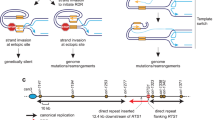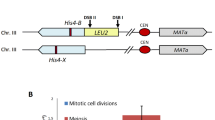Abstract
The RAD52 group of genes in the yeast Saccharomyces cerevisiae controls the repair of DNA damage by a recombinational mechanism. Despite the growing evidence for physical and biochemical interactions between the proteins of this repair group, mutations in individual genes show very different effects on various types of recombination. The RAD59 gene encodes a protein with similarity to Rad52p which plays a role in the repair of damage caused by ionizing radiation. In the present study we have examined the role played by the Rad59 protein in mitotic ectopic recombination and analyzed the genetic interactions with other members of the repair group. We found that Rad59p plays a role in ectopic gene conversion that depends on the presence of Rad52p but is independent of the function of the RecA homologue Rad51p and of the Rad57 protein. The RAD59 gene product also participates in the RAD1-dependent pathway of recombination between direct repeats. We propose that Rad59p may act in a salvage mechanism that operates when the Rad51 filament is not functional.
Similar content being viewed by others
Author information
Authors and Affiliations
Additional information
Received: 3 February / 22 April 1999
Rights and permissions
About this article
Cite this article
Jablonovich, Z., Liefshitz, B., Steinlauf, R. et al. Characterization of the role played by the RAD59 gene of Saccharomyces cerevisiae in ectopic recombination. Curr Genet 36, 13–20 (1999). https://doi.org/10.1007/s002940050467
Issue Date:
DOI: https://doi.org/10.1007/s002940050467




